Sinar Pagi Nasi Padang: Traditional Kapau-style nasi padang with over 40 ingredients since 1960s
Those familiar with Geylang Serai Market and Food Centre will know which stalls garner the most queues. Sinar Pagi Nasi Padang is one of them, as it serves traditional Kapau-style nasi padang with over 40 types of yummy ingredients.
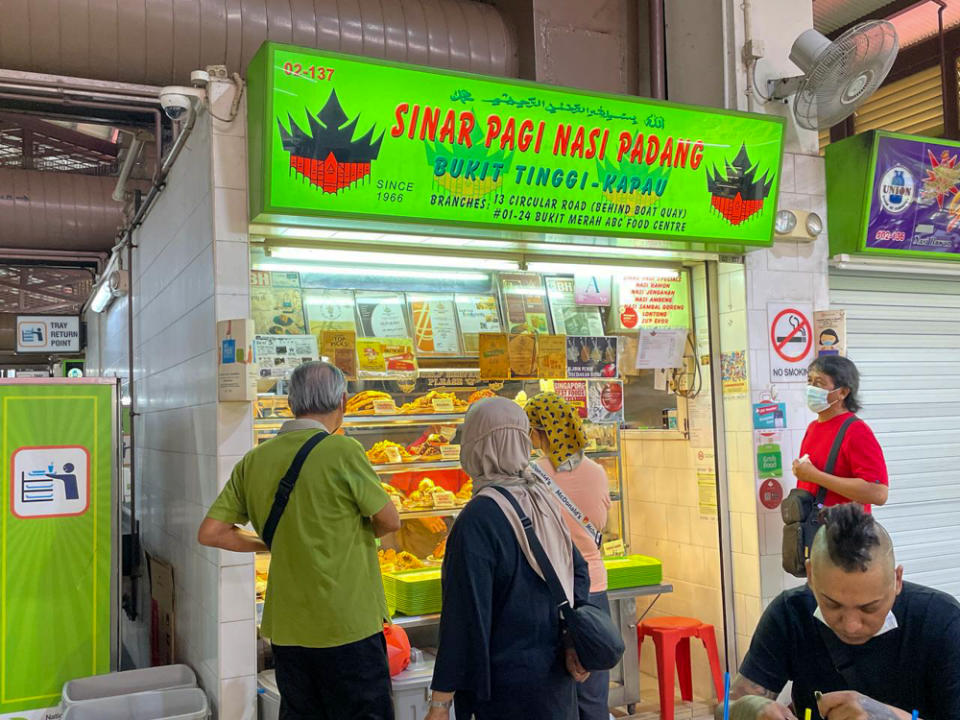
While nasi kapau is incredibly similar to nasi padang, as both consist of steamed white rice and a variety of Indonesian dishes (aka nasi campur), the main difference is where these dishes have originated from.
Nasi padang comes from West Sumatra, Indonesia (it’s actually named after the city of Padang, the capital of West Sumatra), while nasi kapau is from Nagari Kapau, a small village near the town of Bukittingi in West Sumatra.
In essence: nasi kapau is a subset of nasi padang.
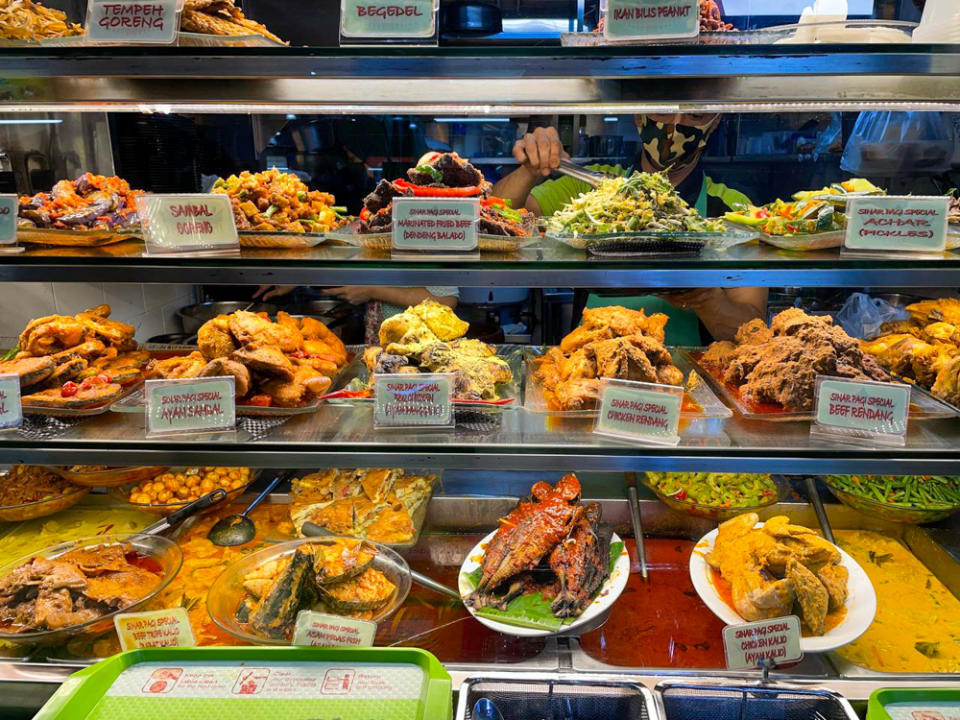
Sinar Pagi Nasi Padang’s history goes back to the 1960s. Its founder and owner, Haji Nasir Kiram, migrated to Singapore from Bukittingi, West Sumatra.
In the 1960s, he started selling authentic nasi kapau in a makeshift stall in Geylang Serai. After Geylang Serai Market & Food Centre opened in 1964, he decided to move there instead, and they’ve been faithfully serving nasi kapau since then, even after the old Geylang Serai Market was demolished in 2006 and eventually rebuilt in 2009.

I visited Sinar Pagi Nasi Padang on a weekday morning, as I heard that they tend to sell out by lunchtime. Despite it being only 9am, I was stunned to see close to 40 ingredients displayed across four rows, including your usual nasi padang fare such as chicken or beef rendang, sambal goreng and sayur lodeh (vegetables stewed in coconut milk).
I’ve got to admit that I was hoping to try some dishes that were specific to nasi kapau, but Sinar Pagi Nasi Padang’s spread looked incredibly similar to those at other nasi padang stalls, even including authentic nasi padang dishes such as fried paru balado (beef lungs), chubadak (young jackfruit), babat kalio (beef tripe) and dendeng balado (marinated fried beef).
Regardless, I went ahead to order anyway. The queue moved slowly, as there was only one staff attending to the customers, with the rest of the staff busy topping up the trays of food with freshly-cooked portions.
What I tried at Sinar Pagi Nasi Padang

Okay, so… I might have over ordered.
Despite ordering three types of vegetables— Brinjal Belado (S$1), Sambal Goreng (S$1) and Sayur Lodeh (S$1)— with one protein of choice, which was Ayam Sambal (S$6), I was shocked to see that I couldn’t even spot my rice underneath all that ingredients.
And mind you, my Ayam Sambal was served on another side plate altogether.
Despite that, the incredibly vibrant colours on my plate was pretty inviting, and I quickly dug in.
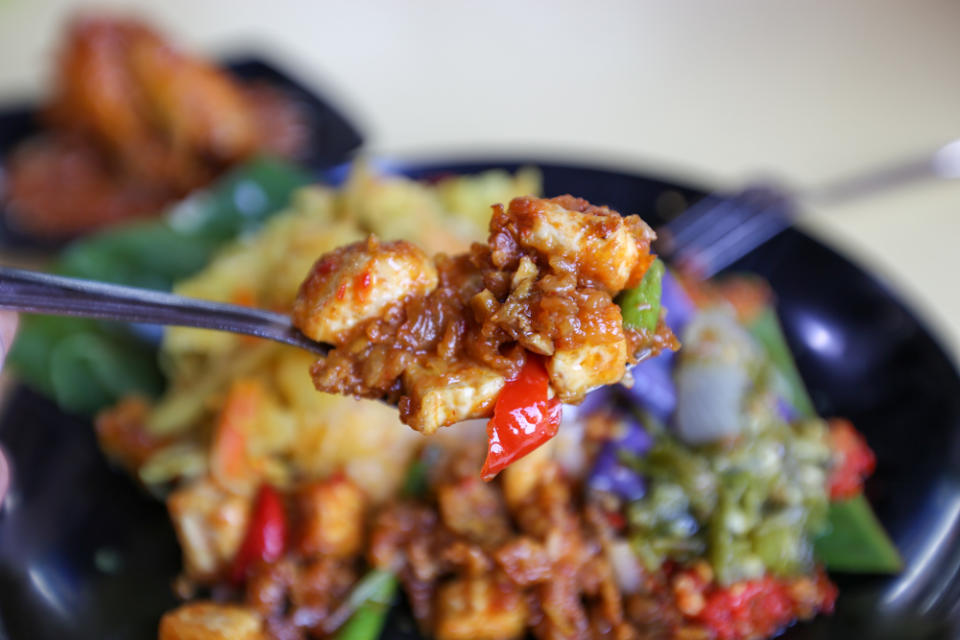
I started the ball rolling with the Sambal Goreng (S$1).
This was absolutely delicious. Every bite burst with sweet and spicy flavours, thanks to the sambal, which was littered with plenty of shallots and garlic, and resembled sweet chilli rather than spicy belacan.
There was a nice crunch from the long beans, and the tofu was nice and firm. I also noticed thin strips of tempeh, which added that extra depth of umami flavours.
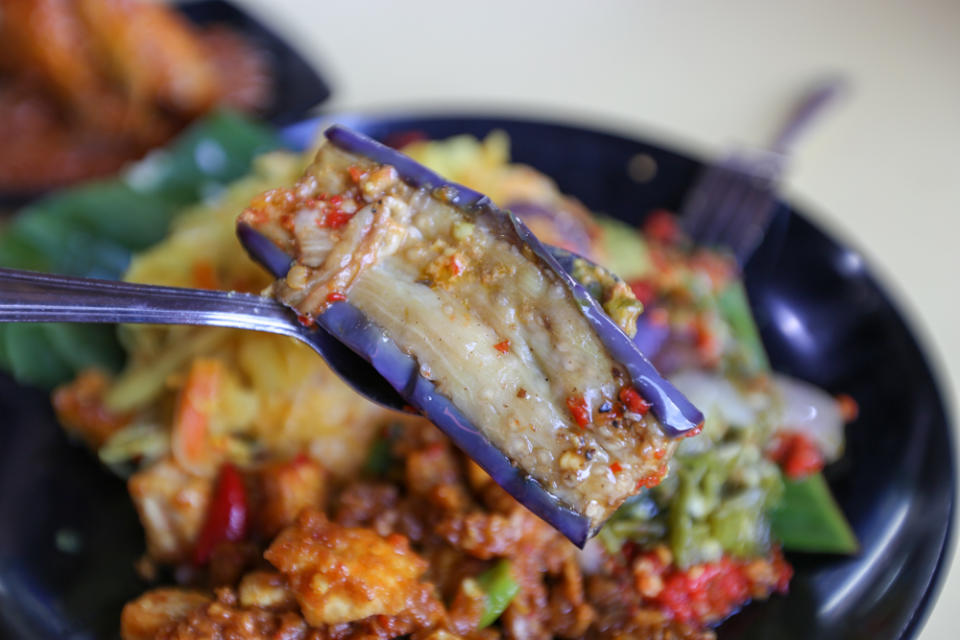
I saw plenty of people ordering the Brinjal Belado (S$1), so I decided to try it too.
The eggplant was pleasantly soft, but despite having a moderately low spice tolerance, I couldn’t taste the spice from the belado (which literally translates to “with chilli” in the Minang dialect).
While I personally would’ve preferred that they added a little more salt and a bigger kick from the chilli, I still enjoyed this dish as it acted as a nice contrast to the other flavours on the plate.
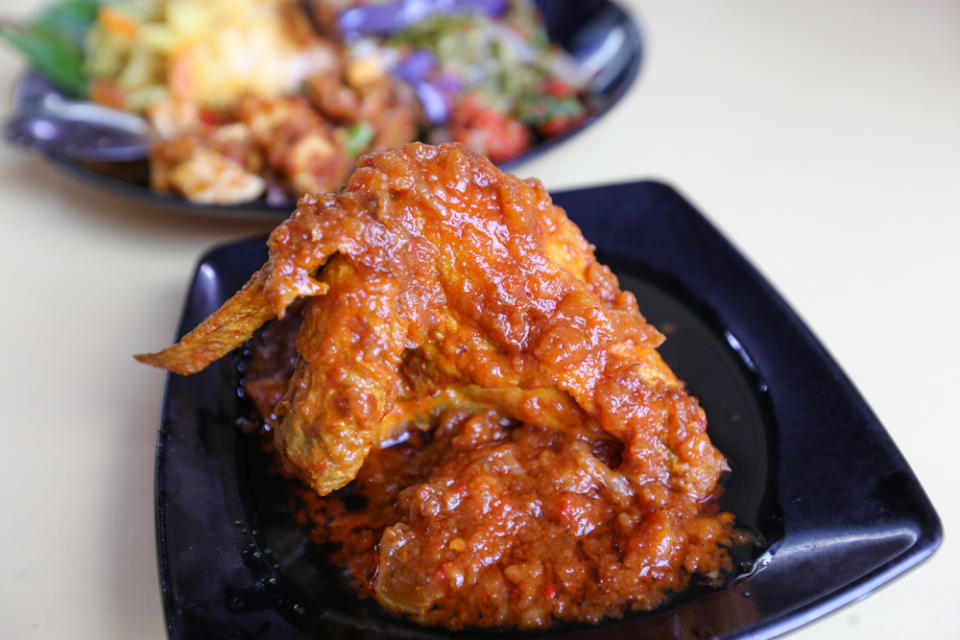
I tackled the Ayam Sambal (S$6) next, and wondered if it’d justify its hefty price tag.
The staff had asked me about my preference of chicken parts upon ordering, as they only have two options available: breast or drum. Though breast meat tends to be a little drier than other chicken parts, I heard plenty of good things about Sinar Pagi Nasi Padang’s chicken breast, so I decided to be brave and ordered that today.
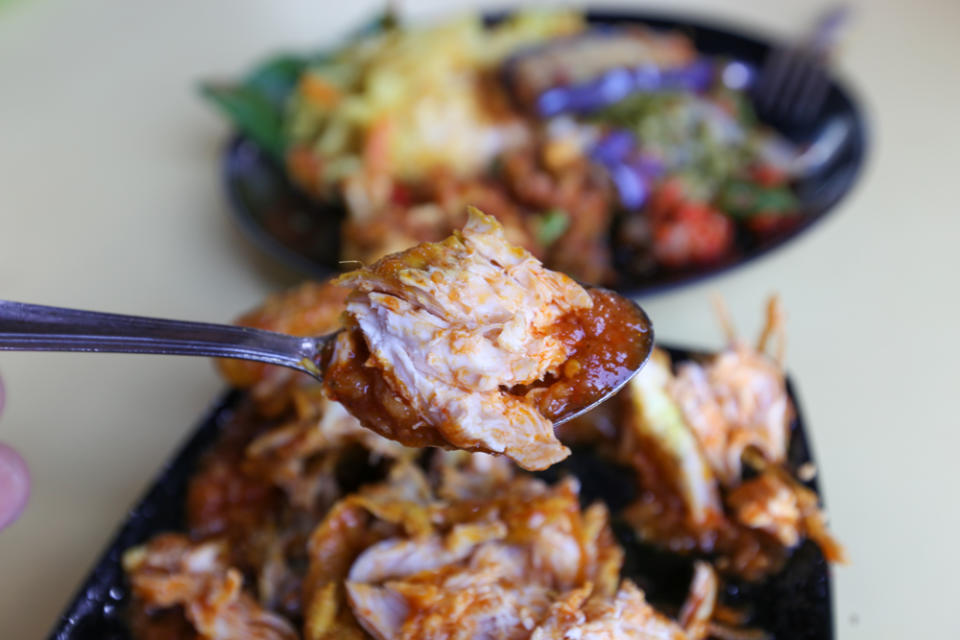
The first thing that hit me was how fragrant and aromatic the sambal sauce was. Rather than the usual sweat-inducing sambal belacan which tends to hit you in a bright and furious way, Sinar Pagi Nasi Padang’s sambal was on the sweeter end, with a delicious full-bodied richness that reminded me of pan-fried shallots.
As for the meat, I wouldn’t say that it’s the most tender chicken meat I’ve had. Yet, it was undeniably juicy, which definitely set it apart. Here’s a tip: shred the chicken meat first and let it soak in the sambal sauce for that extra umami kick.
This was a dish that I thoroughly enjoyed. The portions were generous and I took my time to tear the entire chicken breast apart. While I was initially taken aback by the S$6 price tag, I now realise I could’ve simply ordered this item and one other vegetable, and I’d be set for the meal.

The last ingredient I had on my plate was the Sayur Lodeh (S$1), which is vegetables cooked in curry gravy. This is a staple dish in both Malay and Indonesian cuisines, which typically consists of a mild coconut-based gravy with tofu, tempeh, cabbage and other vegetables including carrots and eggplant.
Sinar Pagi Nasi Padang’s Sayur Lodeh was so delicious that I ended up eating it as it is, scooping mouthfuls of stewed cabbage into my mouth despite already being full. This was super lemak, with a prominent herb-like fragrance from the aromatics that had been added in the gravy. The pleasant milkiness of the coconut milk only came in towards the end of each bite.
My only gripe was not asking for the Sayur Lodeh to be served on the side, so that I could enjoy the gravy as it is, rather than having it poured over the white rice.

Before I end the review, I’ve got to mention Sinar Pagi Nasi Padang’s sambal belacan.
It didn’t hit me on the first bite and frankly, I was a little puzzled and continued eating the belacan as it was. Eventually, I felt a mild spice building up at the base of my throat, but my body reacted to the belacan before the spice reached my tongue— sweat beads started forming on my nose and I felt my stomach burning.
So, trust me when I say this: don’t underestimate Sinar Pagi Nasi Padang’s sambal belacan.
Final thoughts
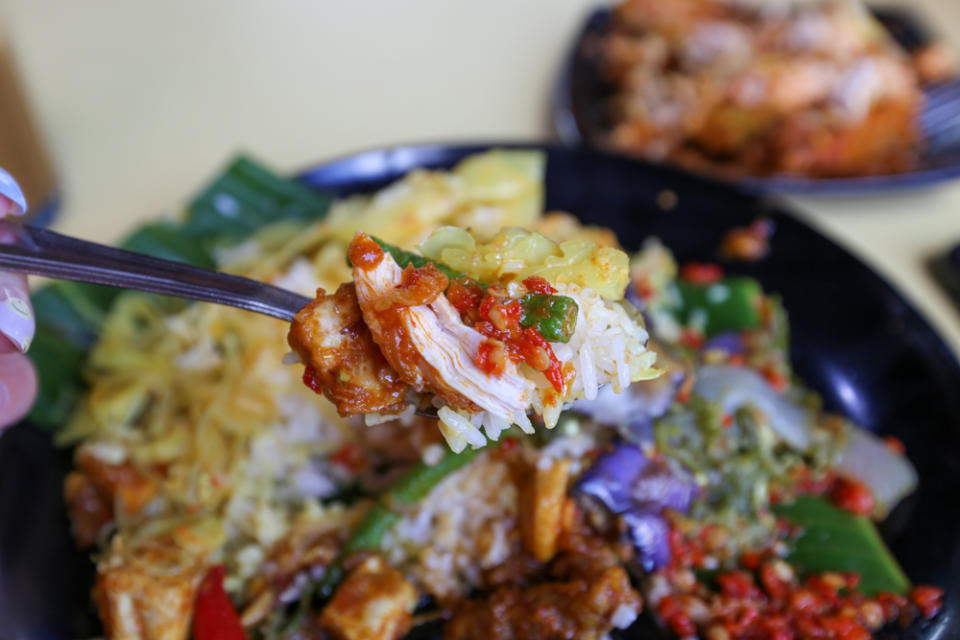
This was a fantastic plate of nasi padang that left me utterly filled. Everything melded together to form a lemak and fragrant bite, with plenty of aromatic spices that had hints of sweetness to balance it out. No wonder this was one of the busiest stalls in Geylang Serai Market & Food Centre, with several people vouching that it sells out by lunchtime.
Though the meat dishes aren’t cheap, starting from S$5 for each serving depending on the choice of meat, I’ve got to say that they’re worth every cent. My best advice to you would be not to over order and go for a simple plate consisting of one protein with one or two servings of vegetables. Heck, go for an entire plate of vegetables if you want— they’re that good.
Expected damage: S$3 – S$10
Other articles you might like:
The post Sinar Pagi Nasi Padang: Traditional Kapau-style nasi padang with over 40 ingredients since 1960s appeared first on SETHLUI.com.

